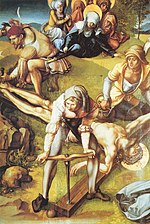|
Seven Sorrows Polyptych
The Seven Sorrows Polyptych is an oil on panel painting by Albrecht Dürer. The painting includes a central picture (108 x 43 cm), now in the Alte Pinakothek in Munich, and seven surrounding panels (measuring some 60 x 46 cm) which are exhibited at the Gemäldegalerie Alte Meister of Dresden. It represents the traditional grouping in Catholic devotion of the Seven Sorrows of the Virgin. DescriptionThe work was commissioned by Frederick III, Elector of Saxony, not a long time after his meeting with Dürer at Nuremberg in April 1496. Stylistic considerations suggest that the artist started to work on the painting only from around 1500. Modern scholars tend to attribute to Dürer only the central panel, the others having been executed by his pupils based on his drawings. The central panel, portraying the Sorrowing Mother, arrived in the Bavarian museum from the Benediktbeuren convent of Munich in the early 19th century. It was restored in the 1930s: once the overpaintings and additions were removed, the shell-shaped niche (a motif typical of Italian art), the halo and the sword (a symbol of Mary of the Seven Sorrows) on the right were rediscovered, clarifying the subject of the work. The other panels were at Wittenberg, seat of Frederick's castle. In 1640 they were moved to the Kunstkammer of the Prince of Saxony. In the mid-20th century they were restored: their conditions improved, but the attribution was not cleared.
See alsoReferences
Further readingKlaus Niehr, "Dürer's Bild der Sieben Schmerzen Mariens und die Bedeutung der retrospektiven Form," in: Marburger Jahrbuch für Kunstwissenschaft, vol. 36, 2009, pp. 117–143. JSTOR 27823074 External linksWikimedia Commons has media related to Altarpiece of the Mater Dolorosa by Albrecht Dürer. |
||||||||||||||||||||||||||||||||||||||||||||








